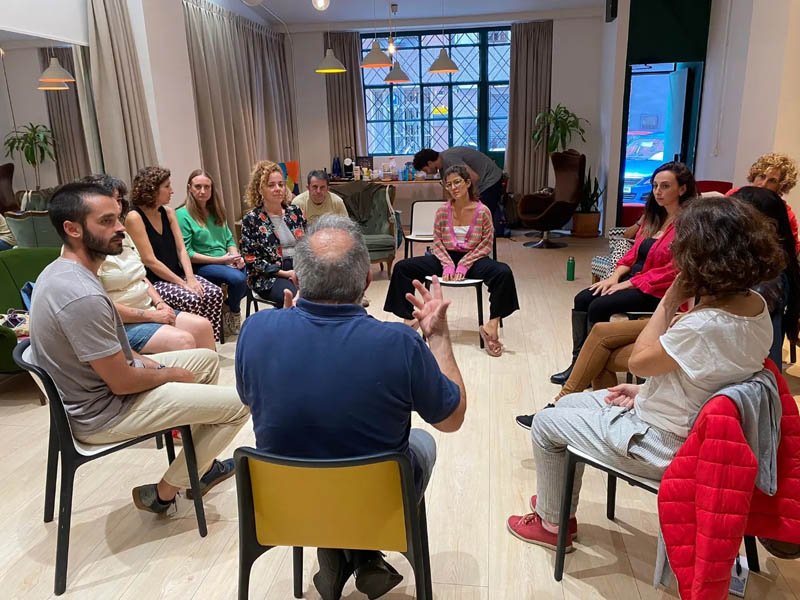The Benefits of Intergenerational Coliving Communities in Valencia
When we think of coliving, we often imagine young, adventurous individuals in their 20s and 30s exploring the world and sharing communal living spaces. However, coliving is no longer just for the younger generations. More and more experienced and mature individuals are now embracing this way of living, living their second youth.
Coliving is usually associated with travel and shared accommodation, attracting digital nomads and foreigners, and seasoned professionals and mature individuals are not often considered in these contexts.
It is assumed that as we age, we settle down and lose our energy and appetite for travel and, especially shared living. But that is not always the case. Many mature individuals are now embracing new adventures, including digital nomadism and coliving - and we’re all here for it.
Why?
Intergenerational coliving communities offer a myriad of benefits, not just for individuals, but for society as a whole. In a coliving community, diverse generations with a common goal can come together, share experiences, learn from each other, and collaborate on projects that have a positive impact on society.
In the continuation, we’ll break down the benefits of intergenerational communities we see as coliving operators.
Generations of different experiences and perspectives
One of the greatest benefits of intergenerational coliving communities is the diverse range of experiences and perspectives that individuals bring to the community. Different generations have different perspectives on things, and when you add different cultures to the mix, the result is an abundant and colorful experience.
The community is co-created in a way that is more inclusive and dynamic when individuals from multiple generations are involved in creating it. With more mature individuals contributing to the community, new activities and things to do might be added that were not previously considered, while the younger generation can provide a fresh perspective and bring in new ideas.
Younger colivers can bring a sense of spontaneity, lightness, and curiosity to the experiences, while older colivers might bring substance and simplicity, and help the group stay grounded and present.
Living in an intergenerational community adds more depth to everyday experiences, whether it's everyday activity such as hiking, watching a movie, cooking, or something more profound such as having a philosophical discussion.
It's not just about learning and education, but also about observing and analyzing situations, people, and different topics from a variety of perspectives. Deepening connections within this diverse group may present some challenges, but it also exposes us to more complexity and pushes us to step out of our shoes, enriching our minds and souls.
The two-way street of learning
Intergenerational coliving communities offer unique opportunities for personal growth and learning, as individuals from different age groups come together and learn from each other. In such communities, younger people can learn valuable life skills from their older peers, while older colivers can gain insights into up-to-date trends and technologies from their younger counterparts.
This two-way street of learning provides a mutually beneficial exchange of knowledge and skills. Older individuals can pass on their wisdom, experience, and practical skills to younger generations, while younger individuals can share their fresh perspectives, innovative ideas, and technological know-how with older generations.
Furthermore, this exchange of knowledge and skills can enhance personal growth and development. Individuals can learn new skills, gain new perspectives, and challenge their assumptions and biases. This can lead to increased empathy, improved communication skills, and a broader understanding of the world.
Mental health and intergenerational support net
Regardless of age, we all experience challenges throughout our lives that can be difficult to navigate alone. Having a support network is fundamental for our well-being, as it provides us with a sense of belonging, security, and comfort.
Intergenerational communities can be incredibly beneficial in this sense, as they offer a diverse range of life experiences, perspectives, and insights that can help us navigate these challenges.
While older individuals might have more experience dealing with certain challenges that younger ones have yet to face, younger individuals can bring their own unique experiences and perspectives to the table.
For instance, older individuals may have more insight into navigating the job market, dealing with aging parents, or other struggles that tend to be more universal and less tied to the fast-changing modern world.
On the other hand, younger individuals may have more familiarity with the digital nomad lifestyle, for example, or other trends and technologies that are reshaping the way we live and work today, which can be overwhelming for older folks, especially given that they don’t have such strong support in pursuing these things as the young do. In that sense, younger folks can help their older peers to face these challenges by facing them together and having someone to lean on while navigating the fast pace of the world.
It can be challenging for people in their 40s or 50s to find like-minded individuals with similar lifestyles while traveling, as this lifestyle choice is still not very common. This is why they must seek connections and support in various communities and across different generations. They may not be able to share their struggles with their peers who do not share the same lifestyle, making it even more essential to have a support system in intergenerational communities.
The Importance of Intergenerational Support Networks for Wellbeing
Finally, it's important to consider the impact that intergenerational communities can have not just within their communities, but also on a wider scale such as local communities, cities, and society as a whole.
Intergenerational communities offer a broader perspective on tackling the challenges of the present.
By including people from different generations in making important decisions or designs, we can see issues and solutions from a more universal perspective, taking into account the needs and experiences of a wider range of people. This is particularly important for tackling complex challenges that require innovative and inclusive solutions.
By engaging in intergenerational dialogue and collaboration, we can leverage the strengths and knowledge of different generations to achieve more impactful and sustainable outcomes. It's only by working together across generations that we can truly address the pressing issues of our time.
Intergenerational community in the context of Vivarium
In Vivarium, while the majority of our guests still fall between the ages of 25 and 35, we embrace and welcome individuals from all age groups and we’ve had some amazing experiences juggling different generations.
As a coliving, we love seeing our spaces become a hub for different generations to come together and build meaningful connections, share their passions and experiences, and create lasting memories.
By fostering intergenerational communities, we want to create a more cohesive and empathetic community that values and respects individuals from all age groups and makes the world more open and welcoming for all.



